Notikumi
Veidojiet inteliģentas lietotnes
17. marts 23 - 21. marts 23
Pievienojieties meetup sērijai, lai kopā ar citiem izstrādātājiem un ekspertiem izveidotu mērogojamus AI risinājumus, kuru pamatā ir reālas lietošanas gadījumi.
Reģistrēties tūlītŠī pārlūkprogramma vairs netiek atbalstīta.
Jauniniet uz Microsoft Edge, lai izmantotu jaunāko līdzekļu, drošības atjauninājumu un tehniskā atbalsta sniegtās priekšrocības.
Azure DevOps Services | Azure DevOps Server 2022 - Azure DevOps Server 2019
Adding tasks to backlog items is essential for tracking the work required to implement them. Tasks also help estimate the effort assigned to individual team members and the team as a whole. The capacity tool indicates how much work your team can commit to. To effectively compare capacity with planned work, define and estimate tasks for each backlog item.
By effectively adding and managing tasks, your team gains a clear understanding of the relative importance and required effort for each item, ensuring better workload distribution and project planning.
| Category | Requirements |
|---|---|
| Project access | Project member. |
| Permissions | - Member of the Contributors or Project Administrators security group. To get added, see Add users to a project or team. - To view or modify work items: View work items in this node and Edit work items in this node permissions set to Allow. By default, the Contributors group has this permission. For more information, see Set permissions and access for work tracking. |
| Access levels | To add work items and exercise all board features: At least Basic access. |
| Sprint backlog | Tasks on your sprint backlog. |
Piezīme
Users assigned Stakeholder access can't update fields displayed on cards or use the Planning pane to change the sprint assignment.
Piezīme
Users with Stakeholder access can't add tasks, update fields displayed on cards, drag-and-drop tasks to update status, or use the Planning pane to change the sprint assignment.
From your project, open the sprint backlog for your team.
Select Boards > Sprints.
Select the correct Team from the team selector menu.
Choose Taskboard.
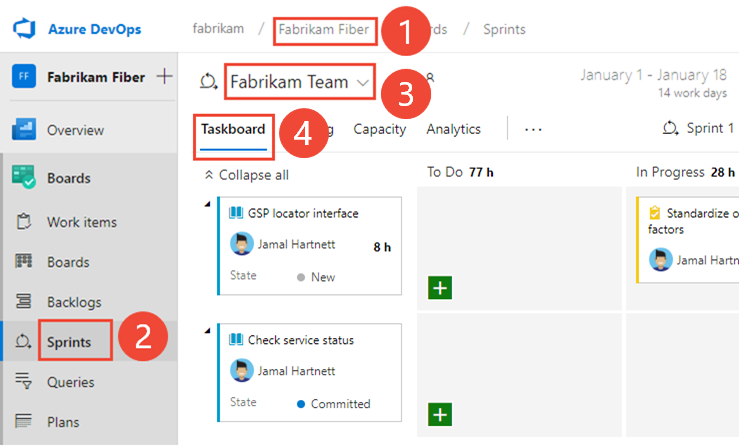
To choose another team, open the selector and select a different team or choose the View sprints directory or Browse all sprints option. Or, you can enter a keyword in the search box to filter the list of team backlogs for the project.
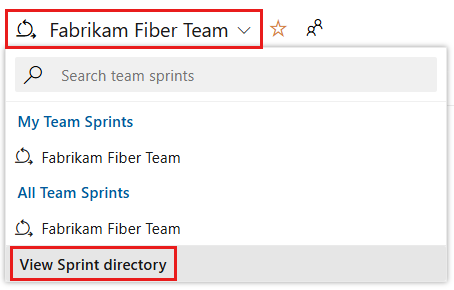
To choose a different sprint than the one shown, open the sprint selector and choose the sprint you want.
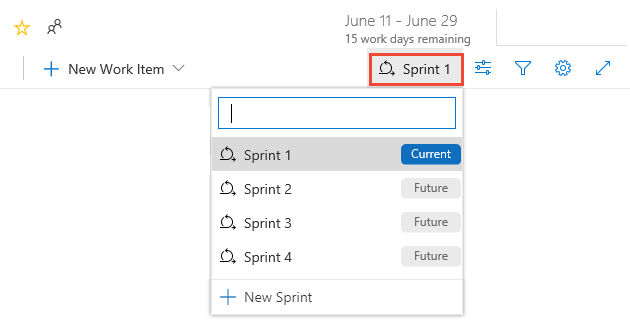
The system lists only those sprints that selected for the current team focus. If you don't see the sprints you want listed, then choose New Sprint from the menu, and then choose Select existing iteration. For more information, see Define iteration (sprint) paths.
From your project, open the sprint backlog for your team. (1) Check that you selected the right project, (2) choose Boards>Sprints, (3) select the correct team from the team selector menu, and lastly (4), choose (4) Taskboard.
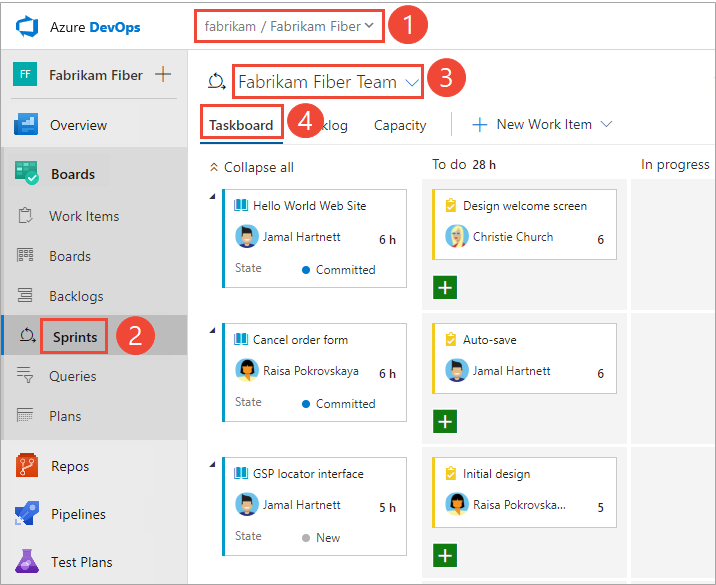
To choose another team, open the selector and select a different team or choose the ![]() Browse all sprints option. Or, you can enter a keyword in the search box to filter the list of team backlogs for the project.
Browse all sprints option. Or, you can enter a keyword in the search box to filter the list of team backlogs for the project.

To choose a different sprint than the one shown, open the sprint selector and choose the sprint you want.

The system lists only those sprints selected for the current team focus. If you don't see the sprints you want listed, then choose New Sprint from the menu, and then choose Select existing iteration. For more information, see Define iteration (sprint) paths.
Each team can customize their Taskboard in the following ways:
Unlike the board for a product backlog, you can't add another columns to the Taskboard via a team configuration setting. Instead, you need to modify the workflow definitions for the task work item type used by the project. Workflow customizations update the columns for the Taskboard for all teams within the project.
An administrator can customize the Taskboard for all teams in the following ways:
An administrator can customize the Taskboard for all teams in the following ways based on the process model selected for the project:
Inherited process model:
On-prem XML process model:
| Control | Function |
|---|---|
| Backlog | Switch to sprint backlog view |
| Board | Switch to Taskboard view |
| Capacity | Switch to Capacity planning |
| Group by Stories/People | Switch grouping of cards based on backlog items or team members |
| Person | Filter tasks to show items assigned to All or a selected team member |
| Open board settings | |
| Enter or exit full screen mode |
See also Backlog keyboard shortcuts.
During your daily Scrum, you can filter your Taskboard to help focus on items of interest.
Piezīme
Your Taskboard automatically refreshes when changes occur. There isn't any live updates control, it simply happens in the background. As other team members move or reorder cards on the taskboard, the Taskboard automatically updates with these changes. You don't need to press F5 to see the latest changes.
Use the Person filter when you want to focus on work assigned to individual team members.
Padoms
If you're seeing tasks that don't belong to your team, check that you've selected the correct team.
With this view, you can quickly see which items are nearing completion and which have yet to be started.
To show cards based on their backlog-to-task groupings, choose ![]() View options and select Stories (for Agile), Issues (for Basic), Backlog items (for Scrum), and Requirements (for CMMI).
View options and select Stories (for Agile), Issues (for Basic), Backlog items (for Scrum), and Requirements (for CMMI).
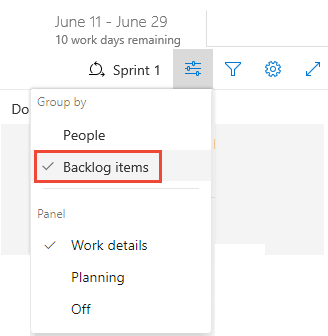
You can Collapse All or Expand All rows, and selectively expand ![]() and collapse
and collapse ![]() a row to focus on a particular item and its tasks.
a row to focus on a particular item and its tasks.
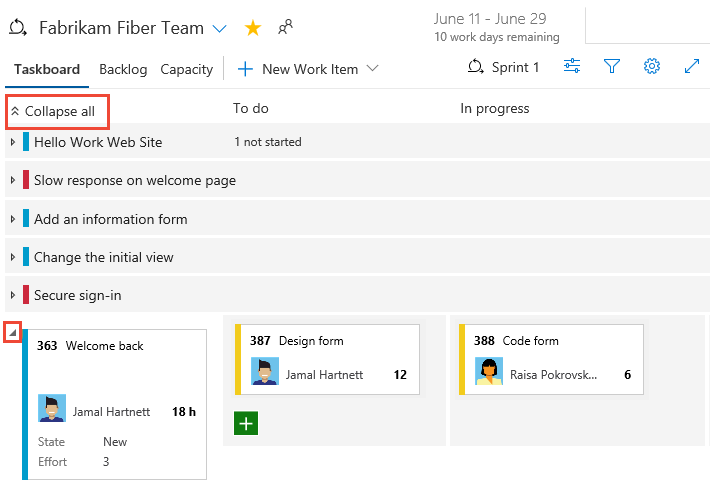
With this view, you can focus on the work completed and the work remaining for each individual team member. You can quickly see who might need help with completing their sprint tasks. This view shows items and tasks assigned to the selected team member.
To filter on the tasks for a specific team member, choose the ![]() filter icon, and then select their name from the Assigned to filter box.
filter icon, and then select their name from the Assigned to filter box.
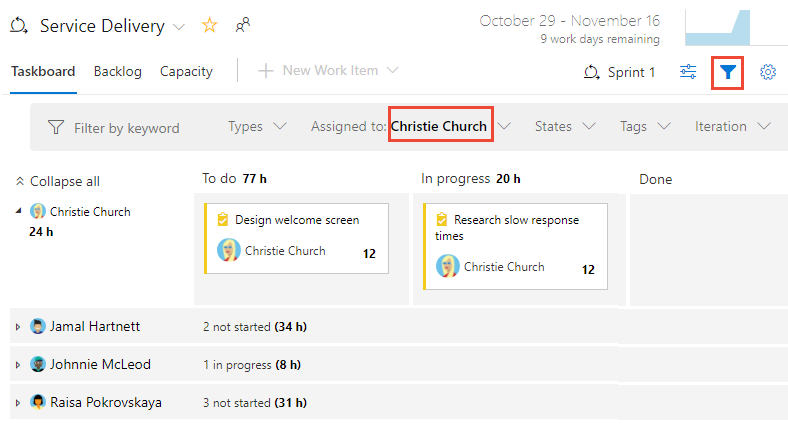
With this view, you can quickly see all the tasks associated with each team member. Backlog items don't appear in this view, only the tasks associated with each individual.
Choose the ![]() view options icon and select People.
view options icon and select People.
Only those team members with tasks assigned to them are listed. All their tasks are shown as cards under their column state.
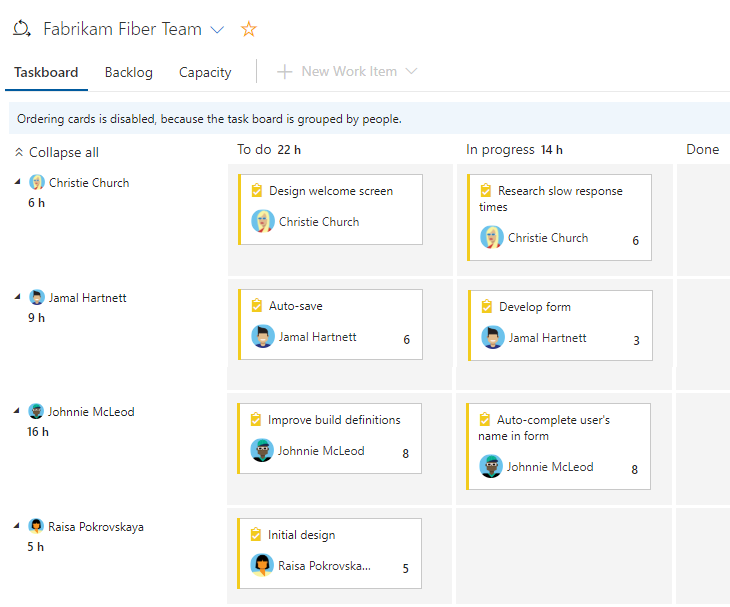
To filter on the tasks for a specific team member, choose Filter ![]() , and then select their name from the Assigned to filter box. For more information, see Interactively filter backlogs, boards, queries, and plans.
, and then select their name from the Assigned to filter box. For more information, see Interactively filter backlogs, boards, queries, and plans.
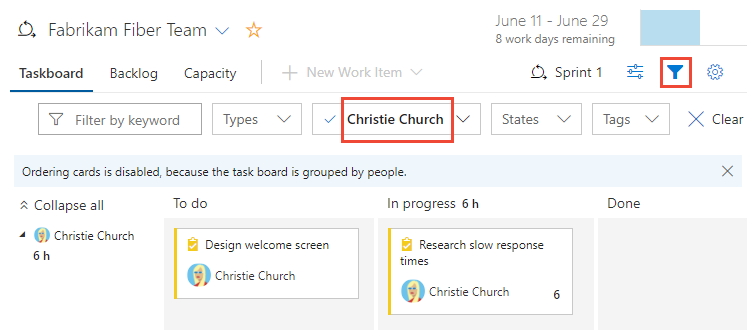
The Taskboard makes quick work of updating both task status and remaining work.
Drag tasks to a downstream column to reflect if they are in progress or completed.
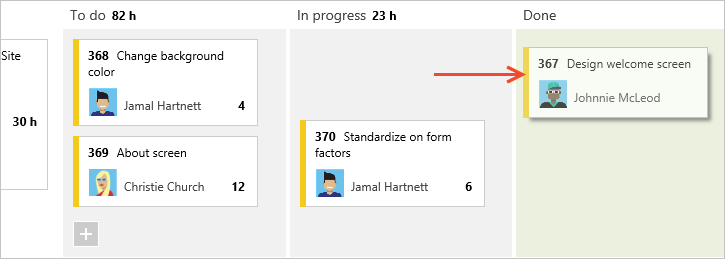
When you move a task to the Done or Completed column, the system automatically updates the Remaining Work field to 0 in all processes, except CMMI. If you discover more work is remaining, change the State back to In progress or To do, and enter a value for the Remaining Work.
Update Remaining Work, preferably before the daily Scrum meeting, which helps the team stay informed of the progress being made. It also ensures a smoother burndown chart.
Each team member can review the tasks they worked on and estimate the work remaining. If they discover that it's taking longer than expected to complete, they should increase the Remaining Work for the task. Remaining Work should always reflect exactly how much work the team member estimates is remaining to complete the task.
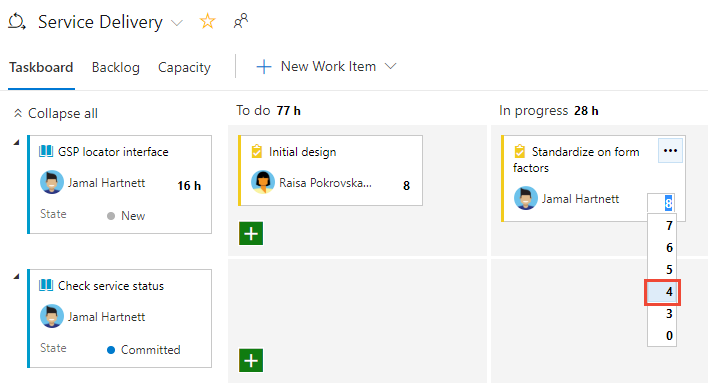
At the end of the sprint, complete these final tasks:
Drag an incomplete item to the product backlog or to a future sprint updates the Iteration Path of all unfinished child tasks to correspond to the product-backlog iteration path or future sprint.
See also End of sprint activities.
If you exceed the number of items allowed on your Taskboard, you receive a message indicating that you need to reduce the number of items. The maximum number of items includes work item types included in the Requirement and Task categories.
You can reduce the number of items on the Taskboard by moving them to the backlog or another sprint. When you move a parent PBI or user story, all active child tasks (State not equal to Done or Closed) automatically move with the parent item.

Or, if your project uses an On-premises XML process, you can increase the maximum number of allowed items.
Notikumi
Veidojiet inteliģentas lietotnes
17. marts 23 - 21. marts 23
Pievienojieties meetup sērijai, lai kopā ar citiem izstrādātājiem un ekspertiem izveidotu mērogojamus AI risinājumus, kuru pamatā ir reālas lietošanas gadījumi.
Reģistrēties tūlītApmācība
Mācību ceļš
Use advance techniques in canvas apps to perform custom updates and optimization - Training
Use advance techniques in canvas apps to perform custom updates and optimization
Dokumentācija
Set the team sprint capacity in Azure Boards - Azure Boards
In this tutorial, determine team capacity, adjust work to fit team capacity, and set capacity for a sprint in Azure Boards.
Assign backlog items to a sprint - Azure Boards
Learn how to assign work to a sprint or iteration using Agile processes and tools in Azure Boards.
Manage sprint timelines while working in Scrum - Azure Boards
Learn how to add and set dates for sprints, releases, or iterations to implement Scrum in Azure Boards.